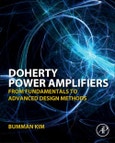Doherty Power Amplifiers: From Fundamentals to Advanced Design Methods is a great resource for both RF and microwave engineers and graduate students who want to understand and implement the technology into future base station and mobile handset systems. The book introduces the very basic operational principles of the Doherty Amplifier and its non-ideal behaviors. The different transconductance requirements for carrier and peaking amplifiers, reactive element effect, and knee voltage effect are described. In addition, several methods to correct imperfections are introduced, such as uneven input drive, gate bias adaptation, dual input drive and the offset line technique.
Advanced design methods of Doherty Amplifiers are also explained, including multistage/multiway Doherty power amplifiers which can enhance the efficiency of the amplification of a highly-modulated signal. Other covered topics include signal tracking operation which increases the dynamic range, highly efficient saturated amplifiers, and broadband amplifiers, amongst other comprehensive, related topics.
Please Note: This is an On Demand product, delivery may take up to 11 working days after payment has been received.
Table of Contents
1. Introduction to Doherty Power Amplifier 2. Enhanced Doherty Power Amplifier 3. Advanced Doherty Power Amplifier 4. Advanced Architecture of Doherty Amplifier 5. Linear Doherty PA for Handset Application








